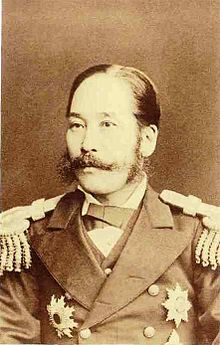Enomoto Takeaki
President of the Republic of Ezo | |
|---|---|
| In office 27 January 1869 – 27 June 1869 | |
| Vice President | Matsudaira Tarō |
| Preceded by | Position established |
| Succeeded by | Position abolished |
| Personal details | |
| Born | 5 October 1836 |
| Spouse |
Hayashi Tatsu
(m. 1867; died 1892) |
| Children |
|
| Parents |
|
| Relatives | Enomoto Takeshi (brother) |
| Military service | |
| Allegiance | Naval Battle of Hakodate Bay |
Viscount Enomoto Takeaki (榎本 武揚, 5 October 1836 – 26 October 1908) was a Japanese samurai and admiral of the Tokugawa navy of Bakumatsu period Japan, who remained faithful to the Tokugawa shogunate and fought against the new Meiji government until the end of the Boshin War. He later served in the Meiji government as one of the founders of the Imperial Japanese Navy.
Biography
Early life
Enomoto was born as a member of a samurai family in the direct service of the Tokugawa clan in the Shitaya district of Edo (modern Taitō, Tokyo). Enomoto started learning Dutch in the 1850s, and after Japan's forced "opening" by Commodore Matthew Perry in 1854, he studied at the Tokugawa shogunate's Naval Training Center in Nagasaki and at the Tsukiji Warship Training Center in Edo.
At the age of 26, Enomoto was sent to the Netherlands to study western techniques in naval warfare and to procure western technologies. He stayed in Europe from 1862 to 1867, and became fluent in both the Dutch and English languages.[1]
Enomoto returned to Japan on board the Kaiyō Maru, a steam warship purchased from the Netherlands by the Shogunal government. During his stay in Europe, Enomoto had realized that the telegraph would be an important means of communication in the future, and started planning a system to connect Edo and Yokohama. Upon his return, Enomoto was promoted to Kaigun Fukusōsai (海軍副総裁), the second highest rank in the Tokugawa Navy, at the age of 31. He also received the court title of Izumi-no-kami (和泉守).
-
Enomoto in The Hague, 1864
-
Enomoto Takeaki in Holland 1863-1866
Boshin War and Meiji Restoration
During the Meiji Restoration, after the surrender of Edo in 1868 during the Boshin War to forces loyal to the Satchō Alliance, Enomoto refused to deliver up his warships, and escaped to Hakodate in Hokkaido with the remainder of the Tokugawa Navy and a handful of French military advisers and their leader Jules Brunet. His fleet of eight steam warships was the strongest in Japan at the time.
Enomoto hoped to create an independent country under the rule of the Tokugawa family in
The Meiji government forces engaged and defeated Enomoto's forces in the
-
8 Tokugawa Warships led by Enomoto sailing Off Shinagawa 1868
-
Enomoto Takeaki in Ezo, aged 32 (c. 1868–1869)
As a Meiji politician

After his surrender, Enomoto was arrested, accused of high treason and imprisoned. However, the leaders of the new Meiji government (largely at the insistence of Kuroda Kiyotaka) realized that Enomoto's various talents and accumulated knowledge could be of use, pardoned him in 1872. Enomoto became one of the few former Tokugawa loyalists who made the transition to the new ruling elite, as politics at the time was dominated by men from Chōshū and Satsuma, who had a strong bias against outsiders in general, and former Tokugawa retainers in particular. However, Enomoto was an exception, and rose quickly within the new ruling clique, to a higher status than any other member of the former Tokugawa administrations.
In 1874, Enomoto was given the rank of
In 1880, Enomoto became
In 1887, Enomoto was ennobled to the rank of
Enomoto was especially active in promoting Japanese emigration through settler colonies in the Pacific Ocean and South and Central America. In 1891, he established—against the will of the cabinet of Matsukata Masayoshi—a "section for emigration" in the Foreign Ministry, with the task of encouraging emigration and finding new potential territories for Japanese settlement overseas. Two years later, after leaving the government, Enomoto also helped to establish a private organization, the "Colonial Association", to promote external trade and emigration.
Death
Enomoto died in 1908 at the age of 72. His grave is at the temple of
).Honours

 Grand Cordon of the Order of the Rising Sun (1886)
Grand Cordon of the Order of the Rising Sun (1886)- Senior Second Rank (1896)
 Grand Cordon of the Order of the Paulownia Flowers (1908)
Grand Cordon of the Order of the Paulownia Flowers (1908)
See also
Notes
References
- Kamo, Giichi. Enomoto Takeaki. Chuo Koronsha ISBN 4-12-201509-X(Japanese)
- Yamamoto, Atsuko. Jidai o shissoshita kokusaijin Enomoto Takeaki: Raten Amerika iju no michi o hiraku. Shinzansha (1997).ISBN 4-7972-1541-0(Japanese)
- Akita, George. (1967) Foundations of constitutional government in modern Japan, 1868–1900. Cambridge, Harvard University Press, ISBN 978-0-8248-2560-7.
- Hane, Mikiso. Modern Japan: A Historical Survey. Westview Press (2001). ISBN 0-8133-3756-9
- Hillsborough, Romulus. Shinsengumi: The Shogun's Last Samurai Corps. Tuttle Publishing (2005). ISBN 0-8048-3627-2
- OCLC 31515308
- OCLC 8728400
- OCLC 427566169






